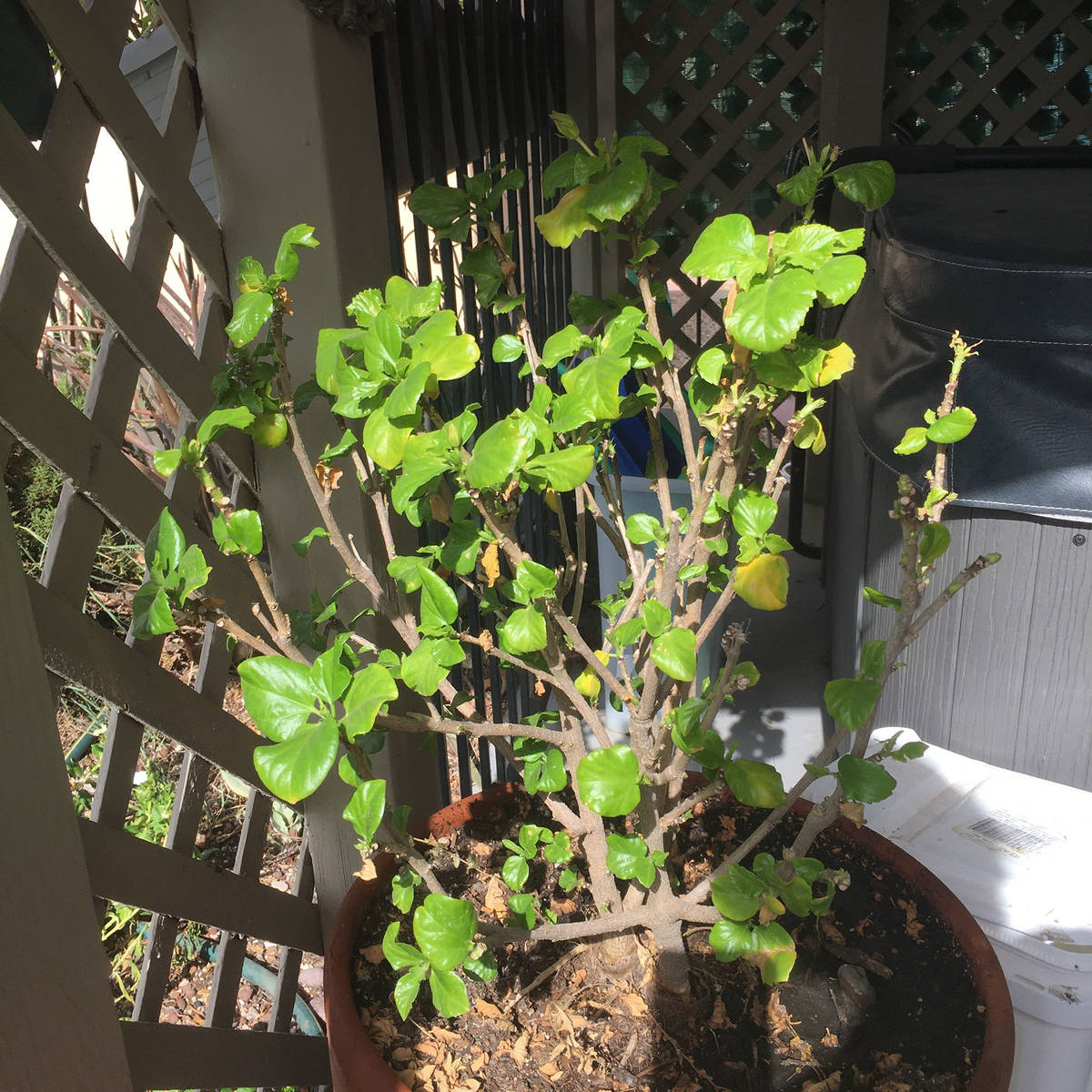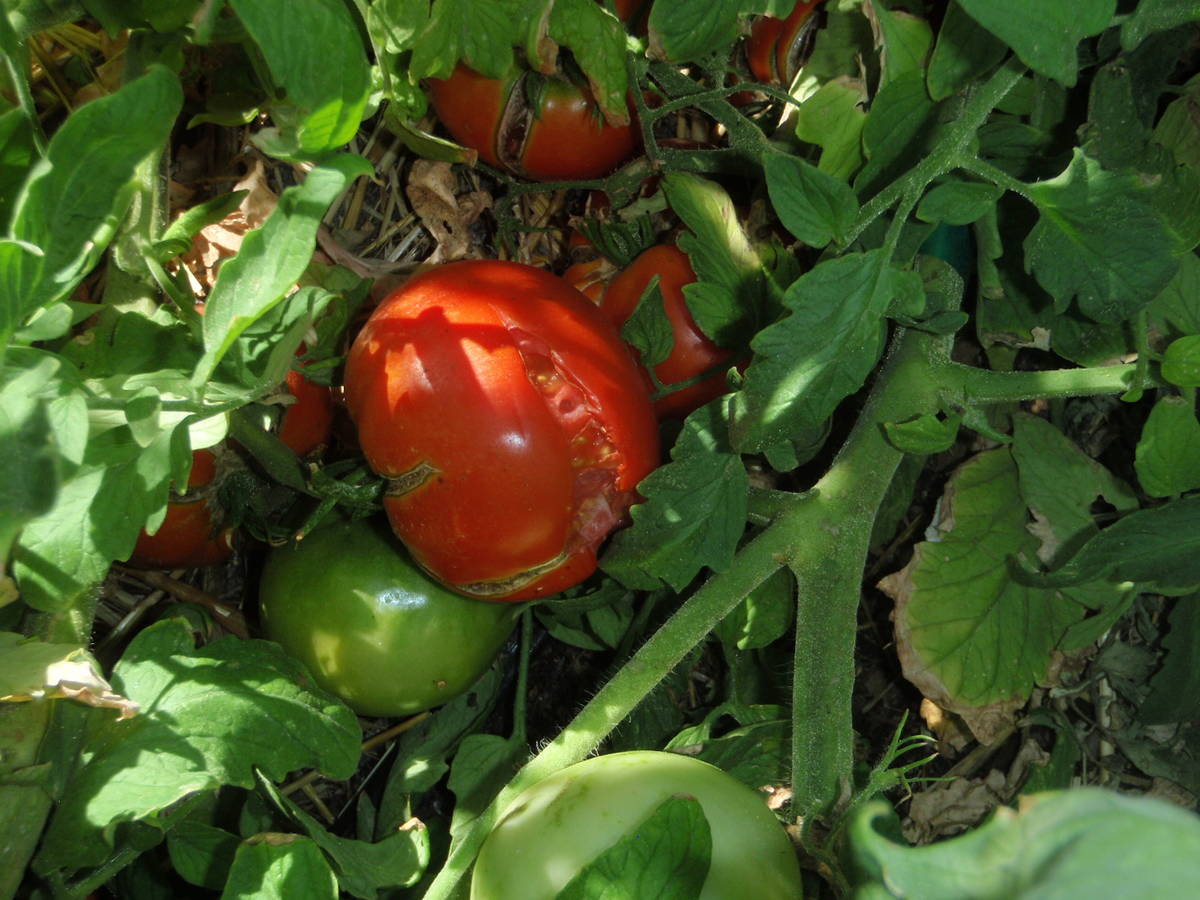Renewal pruning will reinvigorate hibiscus
Q: I have a hibiscus in a 20-inch clay pot with wrinkled flower buds, small leaves and leggy stems. The hibiscus gets filtered light on my south-facing patio and gets hand-watered every other day.
A: I looked at the picture of your potted hibiscus, and I think it is getting too large for its container. This is a 20-inch container, and the size of the main stems are larger than thumb-sized. That’s because you are pruning all of the small stems from the outside and not pruning the larger stems toward the center. Your pruning style is also the reason it’s getting leggy.
I think you have two options: You can either get a larger container or cut the hibiscus smaller. Let me explain how to do renewal pruning on it first. I think that’s your best option.
Renewal pruning, cutting deep inside the shrub and removing larger wood, results in a flush of sucker growth from the remaining stubs that fills the open areas. This flush of sucker growth will be succulent and produce lots of leaves and flowers.
You then select the best suckers to establish a new plant. Basically, you are renewing an older shrub by reinvigorating it.
Prune the main stems as low as 4 to 6 inches from the soil. This sounds dramatic, but in hibiscus, it results in a flush of new growth from below the cuts. Doing that causes it to sucker below the remaining stubs with new growth filling these open areas.
In previous pruning, you were removing growth from the perimeter. Do renewal pruning as soon as the weather cools off in the fall, and new growth will cover the deep pruning cuts before it gets cold.
After you finish renewal pruning your hibiscus, gently ease it out of the container and remove the soil from around the roots. Keeping the roots moist, prune a couple of large roots and replace the soil in the container with fresh soil. Repeat this renewal pruning and repotting process about every three or four years to keep it young and vigorous.
Q: Our tomatoes tend to start splitting when we get rain. We are on a drip system and have steady water all through the growing season. Any help you can give would be appreciated.
A: To prevent cracking or splitting of the largest fruit, the best thing to do is to turn on the drip system just before it starts to rain. I know this sounds counterintuitive, but here is the scientific explanation.
Rainwater enters the fruit and causes it to split because of differences in salt concentrations inside the fruit, which include the sugars and starches, and the rainwater. Turning on the drip system when it begins starts puts water into the fruit, diluting the salt concentrations, and helps reduce cracking or splitting of the fruit.
The second thing to do is harvest large fruit close to maturity before it rains and let it ripen inside the house. The fruits most affected by rain are the larger ones and usually red ones. These two things will reduce fruit splitting but not eliminate it unless you are just plain lucky.
Q: Please advise where I can find this borer control product you recommended to me for soil drenching. The product I found has only 1.47 percent imidacloprid in it. Is this strong enough for soil drenching?
A: This question opens a can of worms I tried to avoid earlier by only recommending a single product. Initially, when evaluating a product for borer control as a liquid soil drench, two questions should be asked: 1. Does this product contain imidacloprid in the ingredients? 2. Do the instructions explain how to apply it as a soil drench to the type of plant I am treating? The instructions will tell you how to use it correctly.
There is frequently a difference in concentrations of imidacloprid between homeowner products and commercial products. The obvious difference, of course, is availability of commercial products to homeowners, but the other one is in the lower concentration that you mentioned.
Homeowner products are frequently less concentrated than commercial products. That is because commercial applicators should have more knowledge about the safe use of these pesticides and access to professional protective equipment when applying it. Plus, the homeowner uses less product.
For commercial applicators, imidacloprid is contained in several products and at concentrations much higher than 1.47 percent. The dose makes the poison, and having a less concentrated product available to homeowners can be safer for the uninformed to use. It also means less leftover product when finished.
Is 1.47 percent strong enough to use as a soil drench? Look at the directions for use. Does it say you can use it as a soil drench for your purpose? A reliable manufacturer will want you to be successful, tell others about your success and use their products again. A reliable manufacturer will give you the right instructions and concentration that will be effective.
It’s up to you to read the directions and make sure this product is applied correctly as a soil drench and for your purposes. Make sure it is applied after the plant flowers in the spring to avoid honeybee problems which it clearly states on the label.
Q: How do you easily separate earthworms from the castings. I raise them in a big pot.
A: There are three basic ways of separating earthworms: by pulling them to a new food source, using light to herd them or screening the soil. Let’s get some vermiculture terminology out of the way first.
Vermiculture is the raising of surface-dwelling earthworms for the purpose of vermicomposting. Vermicomposting is using surface-dwelling worms to make compost rather than a traditional composting method. The product is not called compost but rather vermicast. Vermicast is basically worm poop.
All three of these methods require screening of the vermicast product to remove worms and egg cases called cocoons. It’s faster to screen for renegade worms and cocoons than to rely on screening alone for separation, but it can be done that way.
Putting fresh worm food in a pile for the worms to eat separates them. This method attracts them to one location where they can be transferred to a new location and the vermicast screened and collected. When they congregate around this new food source, remove them from the vermicast, transfer them and begin the process all over again.
The herding method uses light that they hate. Vermicast is dumped into a pile, the worms migrate away from the light as you screen the top of the vermicast. Always leave a thick bottom layer for worm migration. When finished, use the bottom layer full of worms as the inoculation for creating more vermicast.
Q: Is it possible to get more tomatoes on my plants in the fall? What needs to be done to produce them?
A: Yes, you can get a second crop from the existing plants by cutting existing plants back or start new plants directly in the garden from seed. Here’s how to do it.
If you plant seed directly in the garden to replace existing plants, do it now. Plant an early variety from seed such as the Early Girl.
Rake the surface of the soil to create some ridges and put a group of three to four seeds 6 inches from the base of some existing plants you plan to remove. That is for shade. You only want one plant to remain from this group when starting them from seed.
Cover each group of seed with a quarter-inch layer of sand mixed with compost. Water the seeded areas by hand three or four times during the day while it’s hot. Reduce watering to once a day when the seedlings emerge. Remove all other seedlings in a group except the most vigorous.
Lightly fertilize the remaining plant when it’s 2 inches tall. The Early Girl tomato plant should start flowering in about 50 to 60 days.
When cutting back existing tomatoes, make sure they are healthy. Cut them back sometime around early to mid-September when it’s no longer unbearably hot.
Remove the top one-third of the plant by cutting just above a side shoot. Spray the plants with a liquid fertilizer early in the morning. They should start producing flowers and fruit in about three to four weeks.
Bob Morris is a horticulture expert and professor emeritus of the University of Nevada, Las Vegas. Visit his blog at xtremehorticulture.blogspot.com. Send questions to Extremehort@aol.com.



















